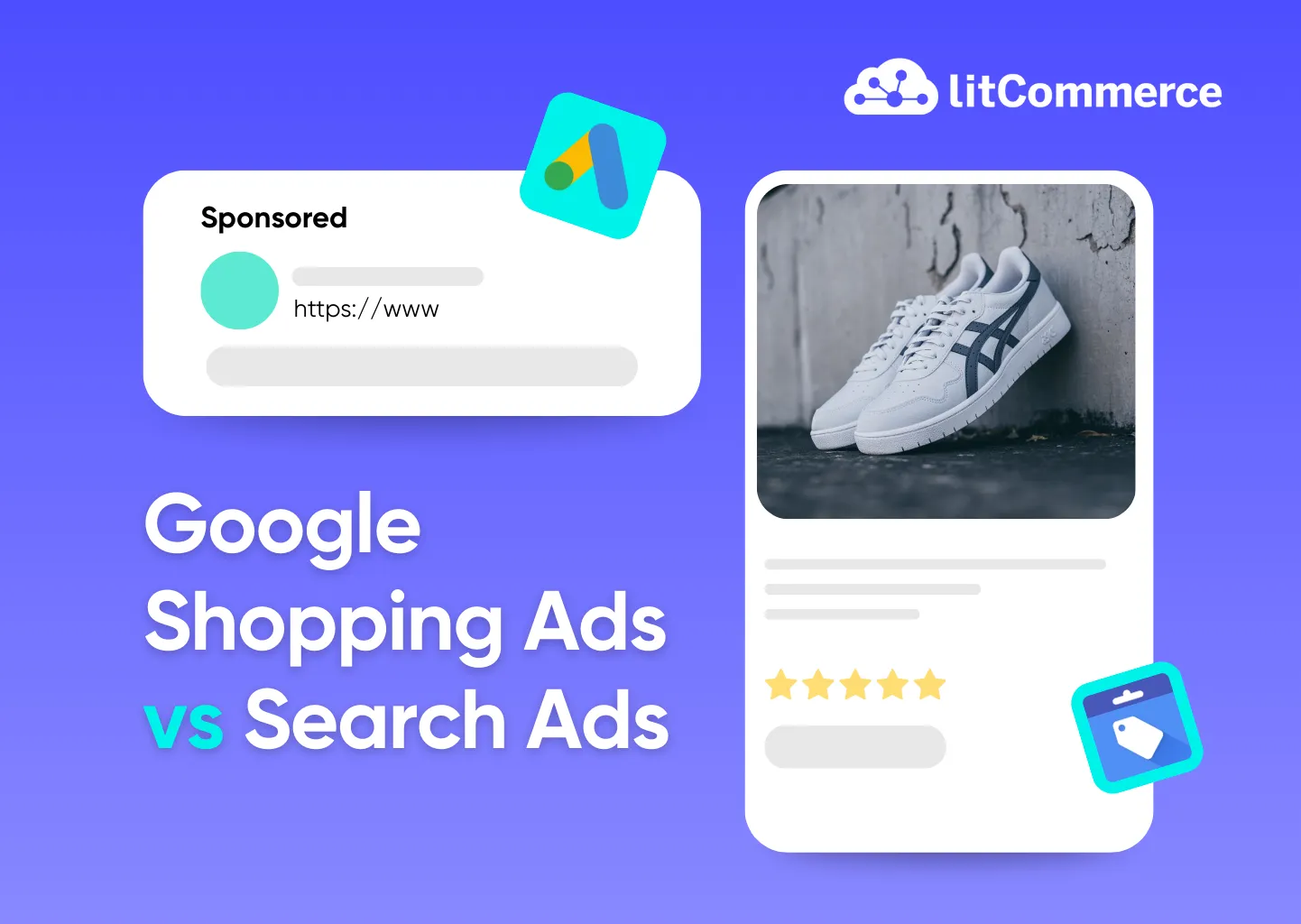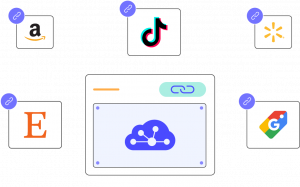When planning a Google Ads strategy, one of the most important decisions businesses might face is choosing between Google Shopping Ads vs Search Ads.
Generally speaking, both ad types appear on Google’s search results page, but they work in very different ways and serve unique purposes. While Google Shopping Ads showcase products with images and prices, Google Search Ads use text to target specific keywords with customizable messages.
In this guide, we’ll break down everything you need to know about Search Ads vs Shopping Ads:
- How they work
- A detailed comparison in terms of various aspects
- Which one is the right one for your business
Let’s get started!
Gain the Best ROI on Your Google Ads with LitCommerce
We provide a range of Google feeds, including options for both Search Ads and Shopping Ads. Each feed is built to streamline your campaigns & expand your reach effectively.
How Google Shopping Ads vs Search Ads Work
When it comes to paid advertising on Google, most people are more familiar with Search Ads than Shopping Ads. Search Ads have been around longer, but Google Shopping Ads have quickly grown in popularity, especially among eCommerce sellers.
So, before diving into the key differences between Google Shopping Ads vs Search Ads, let’s take a quick look at how each type of Google ad works.
How Google Search Ads work
Google Search Ads appear on Google’s Search Engine Results Pages (SERPs) when users type in specific keywords that you have chosen to target. These ads are designed to match the user’s intent by showing relevant offerings based on their search query.
Here is an example: someone searches for “email marketing.” The first few results might include sponsored listings, they are Google Search Ads.
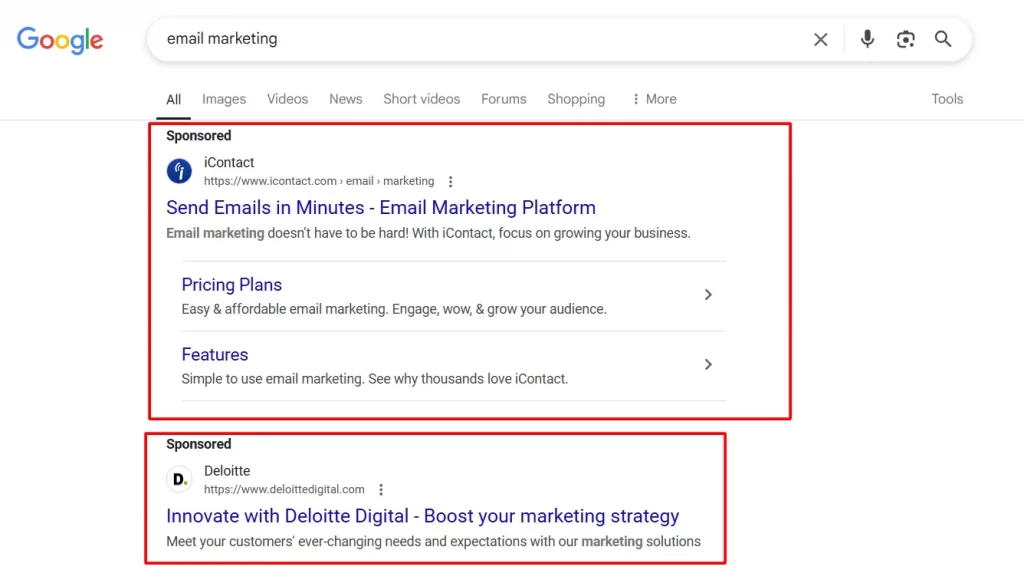
A typical Search Ad consists of 2 core components:
- Title & description: The headline is the bold, clickable link that grabs attention, while the description provides supporting text that summarizes your product, service, or offer
- Ad assets: Assets are optional but highly recommended, extras that expand your ad with additional info and links. These can make your ad more prominent and clickable.
When a user performs a search, Google runs a lightning-fast auction between all eligible you targeting that keyword. The winner isn’t just whoever bids the most, it’s a combination of:
- Bid amount
- Ad relevance and quality
- Expected CTR
- Landing page experience
The better your ad aligns with the user’s intent and search term, the more likely it is to appear at the top, often for a lower cost.
How Google Shopping Ads work
Google Shopping Ads are a powerful way for retailers to promote products directly on the Google Search Results Page, complete with image, price, store name, rating, and sometimes shipping info, all right at the top of the page.
These ads give shoppers a visual and immediate way to browse, compare, and buy, often before they even click through to a website.
For example, if someone searches for “headphones with microphone,” they’ll instantly see a scrolling list of headphones from different brands.
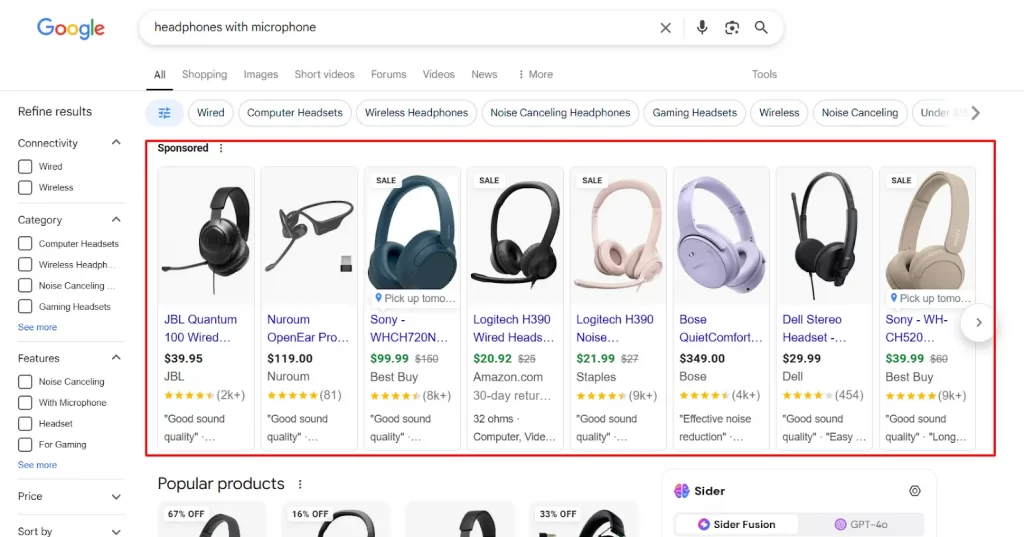
Unlike text-based ads, Google Shopping Ads don’t rely on keywords. Instead, they use a product data feed that you upload through Google Merchant Center. This feed includes essential details such as the product title, description, price, availability, and image.
Google uses this product data to automatically match your ads with relevant user searches, ensuring that shoppers see the most suitable products based on what they’re looking for. There’s no need to manually choose keywords, Google does the matching for you based on your feed content.
What’s more, Shopping Ads operate on a cost-per-click (CPC) model, which means you’re only charged when someone actually clicks on your ad.
How LitCommerce Simplifies Feed Management
With features like Smart Rules, Advanced Categorization, Field Mapping, and Flexible Sync Schedules, LitCommerce makes managing your shopping engine feeds easy and efficient.
If you want to learn more, you can check out our dedicated blog here about Google Shopping
Google Shopping Ads vs Search Ads: A Detailed Comparison
Here’s an overview table of Search Ads vs Shopping Ads comparison:
Factor | Google Search Ads | Google Shopping Ads |
Ad format | Text-based (headlines, descriptions, ad assets) | Image-based (product photo, title, price, store name, rating, etc.) |
Targeting flexibility | High – choose exactly when to show ads | Limited – depends on product titles, descriptions, categories |
ROI potential | Strong if keyword and bidding are well-optimized | Strong if product data and pricing are competitive |
Cost efficiency | Easier to control early on | Can be expensive if product feed or pricing is weak |
Setup complexity | Easier setup, no feed required | Requires Merchant Center setup and product feed |
Time to go live | Very quick – within hours | Longer – feed approval can take 1–3 days |
Bidding strategies | Manual CPC, enhanced CPC, maximize conversions, target ROAS, Smart Bidding | Manual CPC, enhanced CPC, maximize conversions, target ROAS, Smart Shopping (now Performance Max) |
Smart campaigns | Smart Search Ads, Dynamic Search Ads | Smart Shopping (now Performance Max) |
CPC control | Direct and granular | More automated, especially in Smart campaigns |
Audience targeting | In-market, demographics, custom audiences, combined audiences | Automated in Smart campaigns; limited in Standard |
User intent | Covers all funnel stages (informational, navigational, transactional) | Focused on high-buying intent queries |
Best for | Services, digital products, niche products, lead generation | Physical products, eCommerce, visual-first products |
Now, let’s dive deeper into each comparing factor between Search Ads vs Shopping Ads.
Keyword & targeting method
Google Search Ads give you direct control over keywords. You choose which queries you want your ads to appear for using match types like exact, phrase, or broad. You can also add negative keywords – specific words or phrases that you add to your campaigns to prevent your ads from showing for irrelevant or low-intent search queries.
Google Shopping Ads, on the other hand, don’t use keywords at all. Instead, targeting is based on the product data you upload to Google Merchant Center. Google automatically matches your product titles, descriptions, and attributes with user search queries. You can still add negative keywords in Standard Shopping campaigns to filter out unwanted traffic, but overall control is more limited.
Verdict: Google Search Ads offer precise keyword control, while Shopping Ads rely on your product data for automated targeting.
ROI considerations
When comparing Google Shopping Ads vs Search Ads, one of the most important factors is your potential return on investment. ROI depends heavily on your campaign structure, industry, and business goals.
Google Search Ads can be a big win for niche businesses and service-based brands. The average click-through rate (CTR) across industries is approximately 6.42%, and this performance comes at a cost of around $4.66 per click. Still, if you’re targeting high-value leads with strong intent, the return can be well worth it.
On the other hand, Google Shopping Ads typically have a lower average CTR of 0.86%, but they make up for it with a much lower average CPC of just $0.66. Also, Shopping Ads are more competitive, especially in saturated markets, which can drive up costs if your feed isn’t optimized.
Both ad types can deliver solid return on ad spend (ROAS). Search Ads can generate excellent ROAS when your keyword targeting, ad copy, and bidding strategy are well-optimized. And, Shopping Ads are strong when your product data feed is accurate, well-optimized, and competitively priced.
Verdict: Both ad types can deliver a strong ROI, but it largely depends on your objectives and how effectively you implement your strategies.
Campaign structure & setup process
Setting up each ad type involves different tools and structures.
Google Search Ads are managed entirely within Google Ads. You create campaigns and ad groups, select keywords, write ad copy, and choose your bidding strategy. Setup is relatively quick and doesn’t require external tools.
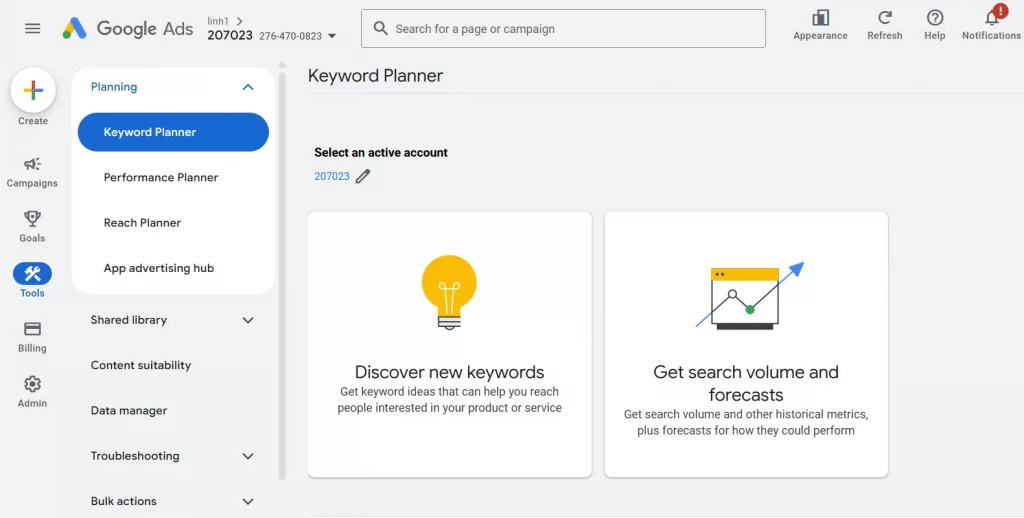
Google Shopping Ads require both Google Merchant Center (for uploading and managing product data feeds) and Google Ads (for running campaigns). You’ll first need to prepare and upload your product feed. Then you build campaigns around product groups instead of keywords.
While Search Ads are faster to launch, Shopping Ads require more prep time. But once set up properly, Shopping campaigns can scale efficiently through automated bidding and Performance Max campaigns.
Verdict: Google Search Ads are quicker to set up with straightforward keyword-based campaigns, while Google Shopping Ads require more preparation but offer scalable efficiency once properly configured.
Learn more about How to build a Shopping ads campaign within Google Merchant Center
Bidding strategies
Both Google Shopping and Search Ads offer a range of bidding strategies, but the level of control and automation differs.
Google Search Ads supports both manual and automated bidding. You can start with Manual CPC for more control, or use Smart Bidding options like:
- Maximize conversions
- Target CPA (cost-per-acquisition)
- Target ROAS (return on ad spend)
- CPM (Cost-per-thousand impressions)
- Enhanced CPC, which adjusts your manual bids in real time
Google Shopping Ads also support manual CPC, enhanced CPC, and Smart bidding strategies like Google Search Ads. However, Smart bidding is especially popular here, particularly with Smart Shopping (Performance Max campaigns), where bidding, targeting, and placement are fully automated.
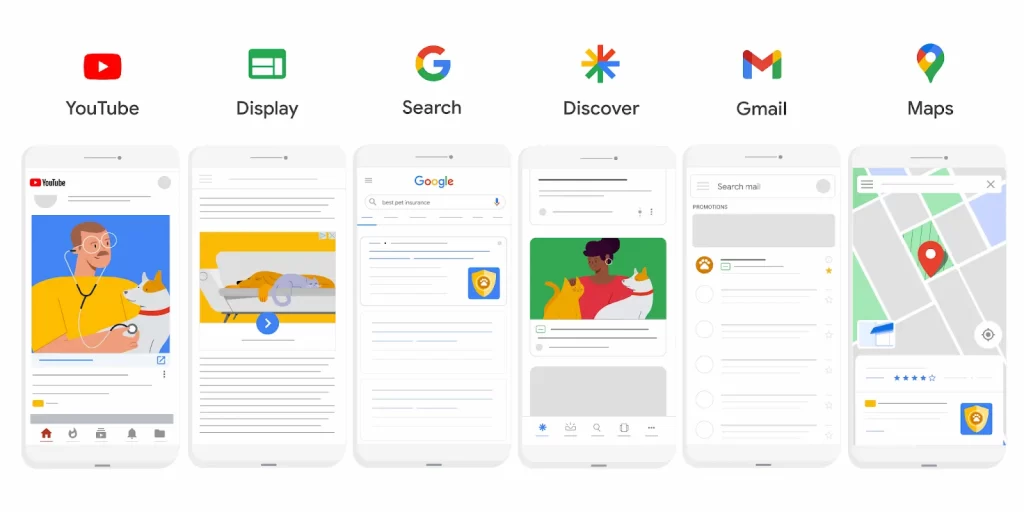
Verdict: If you’re just starting out, Search Ads let you ease into bidding with more control. Shopping campaigns, while powerful, work best when you’re ready to embrace automation and have a well-optimized product feed.
Audience targeting
Audience control is more flexible in Search Ads, while Shopping Ads lean on automation, especially in Smart campaigns.
Google Search Ads allow you to layer audience targeting on top of keyword targeting. You can:
- Target based on demographics (age, gender, income)
- Use in-market and affinity audiences
- Combine audiences for precise segmentation
- Exclude irrelevant segments (e.g., “Unknown” demographics)
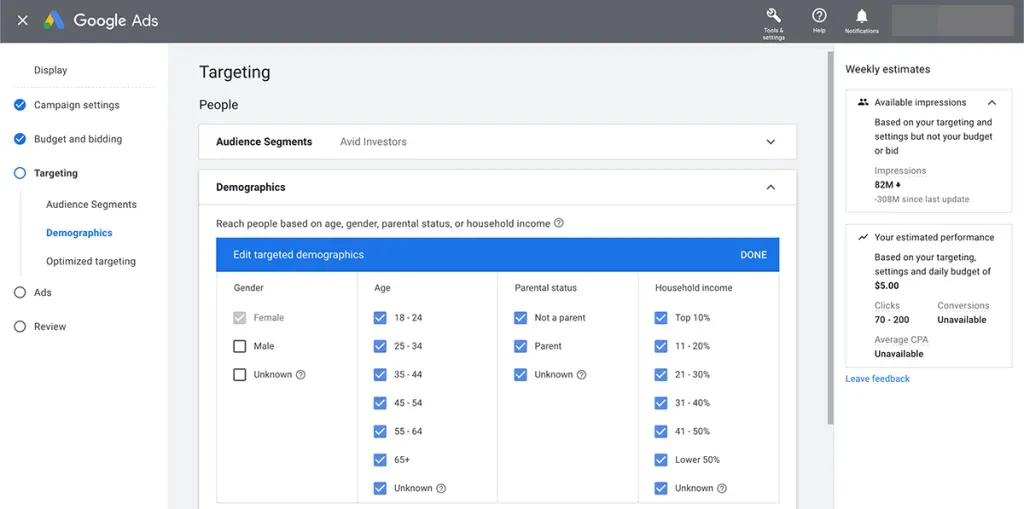
Google Shopping Ads, especially Standard Shopping, offer limited manual audience targeting. You can still adjust bids based on location, device, or schedule, and in some cases, use Customer Match and remarketing audiences. But Smart Shopping automates all audience targeting, giving you less visibility and control.
Verdict: For those who need fine-grained targeting, Search Ads are the better fit. Shopping is great when you’re ready to trust Google’s automation to optimize reach and performance.
Ad format and visuals
This is where the difference between Google Shopping Ads vs Search Ads is most obvious.
Google Search Ads are text-based. You write headlines and descriptions, and optionally include ad assets like sitelinks, callouts, and call extensions. They rely on strong copywriting to capture attention and drive clicks.
Google Shopping Ads are visual product listings. Google automatically pulls information from your product data feed, including:
- Product image
- Title
- Price
- Merchant/store name
- Ratings
- Promotions
Their visual nature makes them highly attractive to shoppers, especially for product-based queries. Shoppers can see exactly what they’re getting before clicking, which often leads to higher conversion rates for retailers.
Verdict: Search Ads are ideal when you want more control over messaging and need to target specific keyword intent, while Shopping Ads allow you to showcase products visually and capture buyers with strong visuals and competitive pricing.
Smart campaigns
Smart campaigns are ideal for those who value ease and automation over detailed control. Powered by AI, these campaigns simplify ad management by handling most of the heavy lifting for you. Just set your budget, select your target locations, and add a few keyword themes, and Google takes care of the rest.
Both Google Search and Shopping support Smart formats, but they function differently.
Google Search Ads offer Smart Search Campaigns and Dynamic Search Ads (DSA):
- Smart Search Campaigns simplify setup by letting Google handle targeting, bidding, and ad creation.
- Dynamic Search Ads pull content directly from your website to auto-generate headlines and target relevant search queries.
These are great if you have large websites or limited time, but they still allow some manual adjustments and insights.
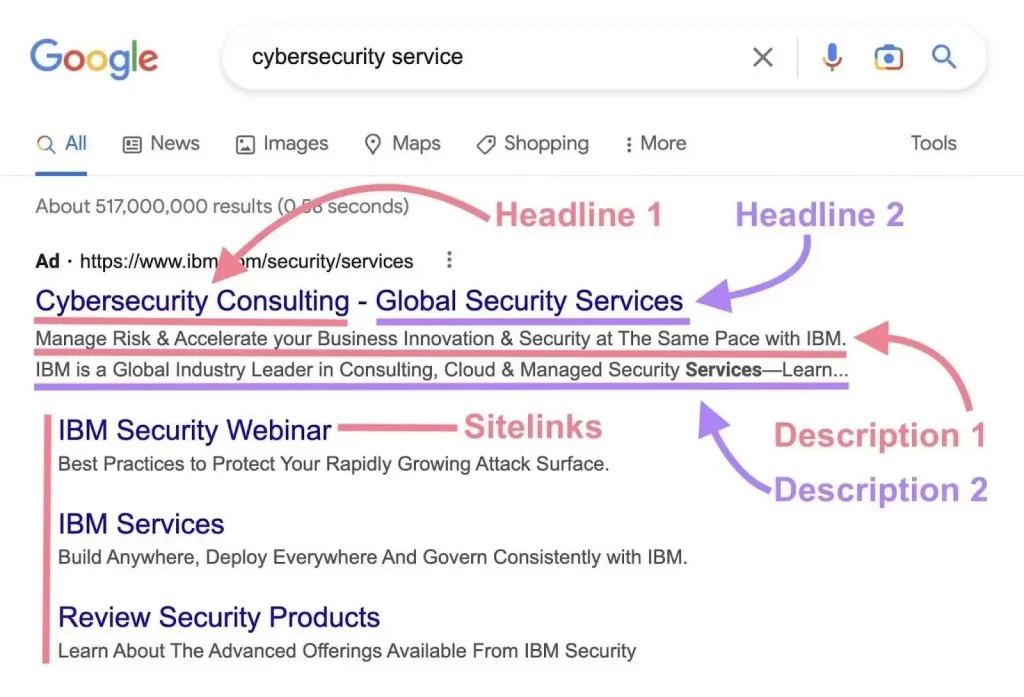
Google Shopping Ads have evolved into Smart Shopping Campaigns, now rebranded under Performance Max. These ads:
- Automate bidding, targeting, placements, and even creative combinations
- Deliver ads across Search, Shopping, YouTube, Gmail, and Display
- Use machine learning to optimize for conversions and ROAS
While Smart Search still gives you visibility into performance by ad group or search term, Smart Shopping (Performance Max) offers much less control, but high potential for performance, especially when you have a solid conversion history and optimized product feed.
User intent
User intent is the underlying goal or purpose behind a person’s online search. It’s the “why” behind every query.
In Google Ads, understanding this intent is essential for creating ads that truly connect with your target audience. When you align your messaging with what users are actually looking for, your ads become more relevant, engaging, and more likely to convert. In short, user intent acts as a guide for crafting high-performing ad campaigns.
Google Search Ads can target a broader range of intent. Since you manually select keywords, you can capture:
- Informational searches (e.g., “best multichannel selling for new eCommerce sellers”)
- Navigational queries (e.g., “LitCommerce” – brand-specific searches)
- Transactional terms (e.g., “buy multichannel selling tool”)
This makes Search Ads ideal for all funnel stages, from awareness to conversion, especially when combined with smart ad copy and audience targeting.
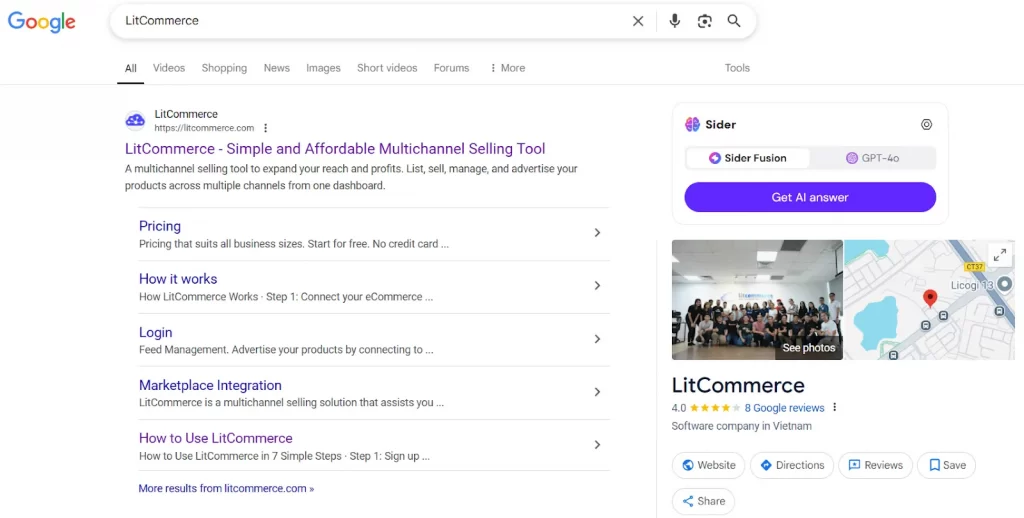
Google Shopping Ads primarily focus on transactional, bottom-of-funnel intent. These ads are triggered by product-related searches like “Nike running shoes size 9” or “Bluetooth speaker under $100,” meaning the user is already comparing or ready to purchase.
When you choose Google Shopping Ads as your primary ad campaign, it’s typically because you want to drive immediate product sales as soon as users see your ads.
Verdict: Shopping Ads are perfect when your goal is high-converting traffic from people who know what they want, while Search Ads are more versatile for nurturing interest and capturing users across different points in the buying journey.
When to Use Search Ads vs Shopping Ads
Choosing between Google Shopping Ads vs Search Ads depends on your business goals, products, target audience, and how much control you want over your campaigns.
Best Google Search Ads use cases
Google Search Ads give you more control over messaging and are perfect when you need to explain your offer, highlight benefits, or reach users at various stages of the buyer’s journey.
Use Search Ads when:
- You’re promoting services, digital products, or subscription-based offers
- You want to target specific keywords with persuasive messaging
- Your product or service requires education or comparison
- You’re a local business looking to drive phone calls, bookings, or foot traffic
- You want to test new markets with lower risk and more control
- You have landing pages tailored to different search intents (e.g., blog, lead form, pricing page)
Best Google Shopping Ads use cases
Google Shopping Ads are ideal when you’re selling products and want to catch buyers at the moment of decision. These are especially powerful for retailers and eCommerce brands with strong visuals and competitive pricing.
Use Shopping Ads when:
- You’re selling consumer goods
- You have high-quality product images and competitive prices
- You want to capture high-intent traffic from users comparing products
- You have a well-structured Google Merchant Center feed
- You’re running seasonal promotions or showcasing new inventory
- You want to promote multiple products at once in a visual carousel format
Pro tip: Use both Search Ads and Shopping Ads
Running both Search Ads and Shopping Ads can boost your visibility, capture different types of buying intent, and help you test what drives the best ROAS.
Maximize Your Google Ads Performance for Free Today!
Get started with LitCommerce’s free plan and experience optimized product feed management. Upgrade anytime as you scale, with support for 300+ platforms beyond Google.
Google Shopping Ads vs Search Ads – FAQs
What is the main difference between Search Ads vs Shopping Ads?
Google Shopping Ads are visual listings that show product images, prices, and store names, pulled from a product feed. While Google Search Ads are text-based ads triggered by keywords and allow more control over the message and targeting.
Are Google Shopping Ads more expensive than Search Ads?
Not necessarily. Shopping Ads often have a higher CTR, but their CPC can vary depending on your product category and competition. Search Ads may have lower CPCs, but performance depends heavily on your keyword strategy and ad quality.
Can I run both Search Ads and Shopping Ads at the same time?
Yes. And it’s often recommended. Running both allows you to dominate more space on the search results page and reach customers across different stages of the buying journey.
Conclusion
When it comes to Google Shopping Ads vs Search Ads, there’s no one-size-fits-all answer. Each ad type serves a different purpose and aligns with different business goals.
Ultimately, the right choice depends on your audience, objectives, and how much control or automation you’re comfortable with. For many sellers, the best approach is to combine both.
And if you’re looking to optimize the performance of your Google Ads, our product feed management tool can help you.
Want more tips and expert insights? Check out our blog for more. If you have any questions, feel free to reach out to us.

